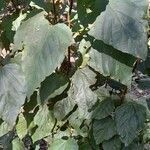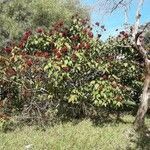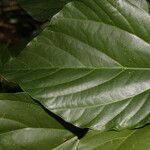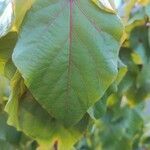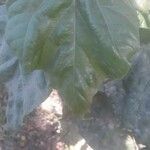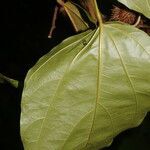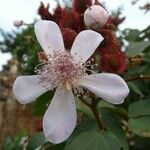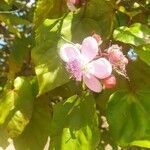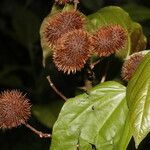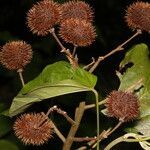triangular, infrequently oblong-ovate, the base truncate or truncate-subcordate or rounded or rounded-subcordate, the apex sometimes acute to generally gradually long-acuminate and with the acumen usually blunt and often inconspicuously mucronulate, entire-margined, 5.5-27 cm long and 3-18 cm wide, membranous to chartaceous, 5-palminerved, slightly discolor, the upper surface usually more or less shining and glabrous or sparsely lepidote especially when young and along the veins, the lower surface dull, paler, more or less densely lepidote, and with the main veins and secondary veins prominent. Panicles small to large, few-to many-flowered, the axes densely covered with minute, reddish-brown scales, the bracts and bracteoles squamiform and fugacious. Flowers with the pedicels up to 1 cm long, densely covered with minute, reddish-brown scales; sepals circular, cucullate, 7-9 mm in diam, densely lepidote outside; petals obovate, rounded at the apex, 20-33 mm long and 8-20 mm wide, white or pink; androecium ca 14-15 mm long, the fila-ments filiform, the anthers ca 1-1.5 mm long; ovary more or less globose to pyri-form, densely to sparsely bristly, the style up to 15 mm long, slightly enlarged towards the apex, glabrous. Capsules very variable in shape, size, and indumentum, oblong-ovoid to ovoid to globose to + reniform to transversely ellipsoid, more or less flat-tended or not, rounded to acute or sometimes acuminate at the apex, 1.3-4.5 cm long and 1.3-4 cm broad, brown to flaming red, densely to sparsely covered with long or sometimes short, flexible spines, sometimes nearly smooth; seeds obovoid-angular, ca 5 mm long, the testa densely reddish-orange papillate. Native to and widely distributed throughout continental tropical America; planted and naturalized in tropical and subtropical regions of the world; known locally as achote or achiote.
Shrub or small tree, 2-8 m high; bark dark-brown, tough; young branchlets densely rusty-scaly, glabrescent. Stipules oblong, acute, 6-10 mm long. Leaves herbaceous, ovate from a shallowly cordate, less often truncate base, gradually long-acuminate, at first densely scaly beneath, glabrescent, very densely red-dotted, 7½-24 by 4-16 cm; 5-nerved; lateral nerves on each side of midrib several, connected by numerous transverse nerves; larger nerves prominent beneath; petiole terete, thickened at base and apex, at first densely scaly, glabrescent, 4½-12 cm long. Panicles or corymbs 8-50-flowered; bracts early caducous, 5-10 mm long. Pedicel terete or subcompressed, thick, densely red-squamose, 8-10 mm long, much thickened at the apex and bearing there 5-6 large, sessile, shining glands alternating with the sepals. Flowers 4-6 cm across. Sepals obovate, concave, obtuse, purple, densely rusty-scaly, 10-12 mm long. Petals 5-7, unequal, obovate, obtuse or retuse, light red, veined, 2-3 by 1-2 cm, on the back with many oblong dots, deciduous. Disk ± 1 mm high. Filaments at the base yellow with a few dots, at the apex red; anthers violet; ovary subglobose, densely clothed with red-blotched bristles, 2½-3½ mm high. Style thickened upwards, 12-15 mm long; stigmatic teeth very short. Ovules red-dotted. Capsule from a subtruncate base either broadly ovate, with a broadly rounded abruptly and shortly acuminate apex (so in most Indonesian specimens) or elongate-ovate with a much narrowed, rather long-acuminate apex, 2-4 cm long, 2-3½ cm wide, more or less densely clothed with long, filiform thickish, very acute, stiffish but not sharp, in a dry state very brittle bristles, at first red, afterwards greenish, finally brown, opening down to the base by two persistent valves; funicles rather long with a disciform apex. Seeds 4-5 mm long.
Shrubs or small trees, evergreen, 2-5(-10) m tall. Branches brown, densely red-brown glandular hairy. Petiole erect, 2.5-5 cm, glabrous; leaf blade abaxially pale green, with resinlike gland dots, adaxially deep green, cordate-ovate or triangular-ovate, (5-)10-25 × (3.3-)5-13(-16.5) cm, palmately 5-veined, glabrous, base rounded or subtruncate, sometimes slightly cordate, margin entire, apex acuminate. Panicles robust, often flat-topped, 5-10 cm, densely red-brown scaly and glandular hairy; bracts caducous, leaving scalelike scars. Flowers 4-5 cm in diam.; pedicel 4-12 mm. Sepals obovate, 8-10 × ca. 7 mm, densely red-brown scaly, with glands at base. Petals bright pink, mauve, or white with pale red veins, obovate, (1-)1.5-3 × 0.8-2 cm. Stamens many; anthers yellow, apically dehiscent. Capsule subglobose or ovoid, slightly laterally compressed, (1.4-)2-4.5 cm, usually densely purple-brown spiny, rarely smooth; spines 1-2 cm. Seeds numerous, red-brown, obovoid-angular, 4-5 mm.
An evergreen tree. It grows to 10 m high and spreads to 3 m across. The stem is erect and it is intricately branched giving the tree a crown which is spreading and graceful. The leaf stalks are long. The leaves are alternate and simple. They are broad and heart shaped. They taper to the tip and have long leaf stalks. The flowers occur in a branched flower stalk. Several of these occur at the ends of branches. The flowers are open and cup-shaped. They can be pink or purple and 5 cm across. The fruit are hairy or bristly and heart shaped capsules. They are 3 cm long. They have a soft red skin. They can be yellow. When they are ripe they turn brown and split open. The capsules contain many dark red seeds.
Tree to 8 m high. Young branchlets lepidote, brown. Leaves ovate, acuminate; lamina 7–24 cm long, 4–16 cm wide, cordate at base, red-dotted, lepidote beneath when young; lateral nerves prominent beneath, connected by many parallel nerves; petiole 4.5–12 cm long; stipules 6–10 mm long. Pedicels 8–10 mm long, the apex with sessile glands alternating with sepals. Flowers 4–6 cm diam. Sepals obovate, obtuse, 10–12 mm long, concave, densely lepidote. Petals 5–7, obovate, unequal, 2–3 cm long, pink or white, dotted outside. Anthers violet. Ovary densely setose. Capsule ovoid, obtuse or acute, c. 5 cm long, covered with red bristles. Seeds 4–5 mm long.
Shrub or tree, usually evergreen, 1.5-10 (15) m tall, the trunk up to 10 cm in diam, the bark lenticellate, the branchlets covered with minute, reddish-brown scales. Leaves with the petioles slender, terete, slightly enlarged at the apex, 1.8-14 cm long, more or less densely covered with minute scales, the stipules narrowly ovate, acuminate at the apex, ca 1 cm long, fugacious; blade ovate or sometimes ovate-
Leaf-lamina 7.5–24 x 4–16 cm., ovate, apex long-acuminate, base cordate or truncate, densely scaly beneath at first, later glabrescent, 5-nerved from the base, petiole up to 12 cm. long, thickened at the base and apex.
Flowers in terminal 8–50-flowered panicles or corymbs; bracts 5–10 mm. long, caducous; pedicels 8–10 mm. long, red-scaly, apex thickened and with 5–6 sessile glands.
Capsule narrowly ovoid, acute, densely covered with stiff, slender bristles, opening to the base by two valves.
Shrub or small tree up to 8 m. tall; branches and rhachis of the inflorescence covered with rusty scales.
Ovary globose, with dense, red-blotched bristles; style 1.2–1.5 cm. long; stigma-lobes very short.
Seeds c. 4 mm. long, numerous, obovoid-angular; testa covered with minute, red, sessile glands.
Sepals 10–12 mm. long, purplish, scaly, obovate, concave, blunt.
Petals 5–7, unequal, obovate, obtuse or refuse, pinkish-white.
An introduced shrub; sometimes subspontaneous.
Anthers violet.
